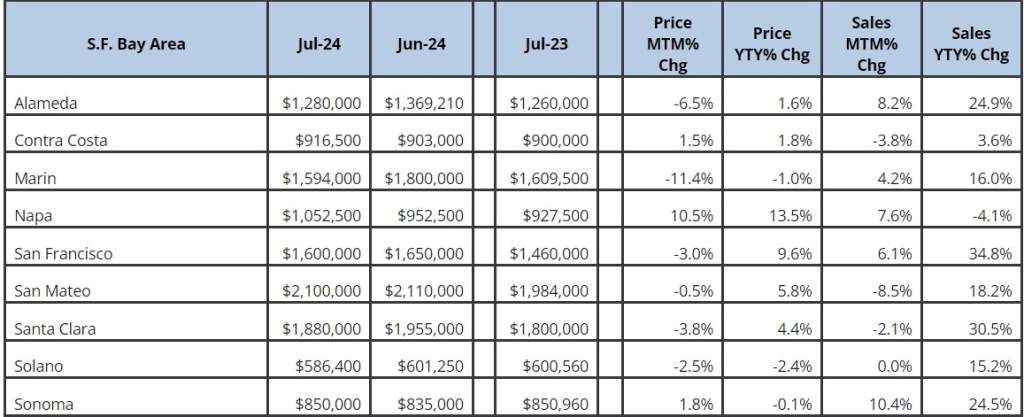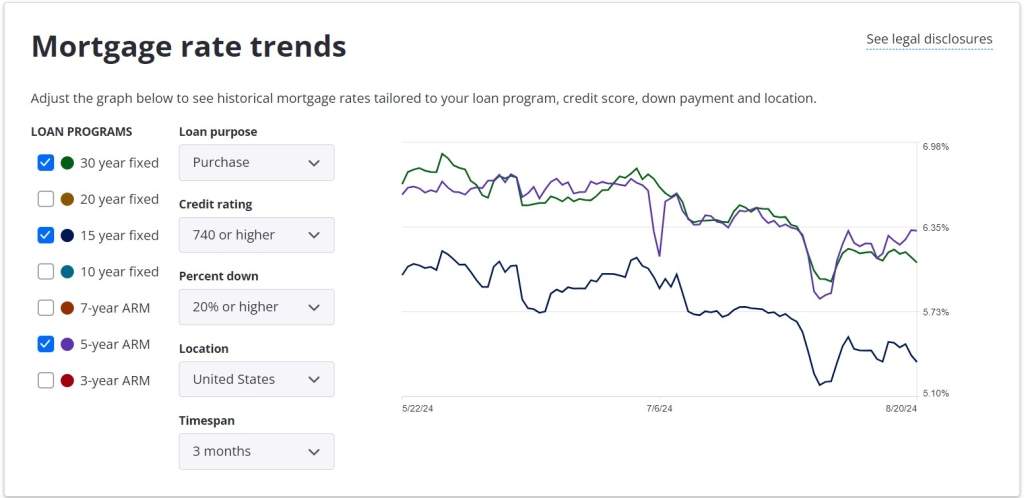The real estate landscape in the San Francisco Bay Area is continuing its dynamic evolution as we move through August 2024. While the overall economic environment is showing signs of moderation, the housing market remains resilient, with several key indicators suggesting a nuanced but optimistic outlook for both buyers and sellers.
Bay Area Housing Market Performance
Year-over-year (Y2Y) changes in home prices across the Bay Area reflect a market that is still experiencing growth, albeit at a more tempered pace compared to previous years.

On a Y2Y basis, most counties saw price increases, with Napa leading the pack with a significant 13.5% rise. San Francisco also saw a notable 9.6% Y2Y price increase, reflecting the city’s enduring appeal despite broader economic uncertainties.
However, month-to-month (MTM) changes tell a different story. Several counties, including Marin and Alameda, experienced notable declines in prices from June to July, with Marin seeing the steepest drop of 11.4%.
This MTM fluctuation could indicate some short-term volatility, perhaps tied to rising interest rates or seasonal market adjustments. Nevertheless, the long-term Y2Y data underscores the continued demand for housing in the Bay Area, even as buyers become more selective and price-sensitive.
Sales Volume: Resilient Demand Despite Challenges
Sales activity, as measured by Y2Y changes, reveals a market that, while not as frenetic as during the height of the pandemic, still shows robust demand. Alameda County, for instance, saw a substantial 24.9% increase in sales Y2Y, and Sonoma wasn’t far behind with a 24.5% increase. This suggests that despite higher mortgage rates, buyers are still active, possibly motivated by the recent dip in mortgage rates below 6.5%.
Interestingly, sales did dip on a MTM basis in some counties like San Mateo and Contra Costa, which could be attributed to the typical seasonal slowdown as we transition out of the peak summer buying season. However, the overall picture remains positive, particularly when considering the broader economic context.

Mortgage Rates: A Glimmer of Hope
One of the more encouraging developments for the housing market is the recent stabilization of mortgage rates. As of late August, rates for a 30-year fixed mortgage have hovered just below 6.5%, providing a bit of relief for prospective buyers.
The sustained low rates are likely contributing to the uptick in sales activity, as buyers who have been holding out don’t want to wait any more.
Additionally, the broader economic backdrop, including lower inflation and a cooling labor market, might give the Federal Reserve the impetus it needs to ease off on rate hikes, or even lower rates later this year.
If that happens, we could see a late-year surge in buying activity, potentially setting the stage for a strong winter housing market—a typically slower period that could see unseasonably high activity.
Economic Indicators: The Good and the Bad
California’s labor market showed a strong headline number in July with 21,000 new jobs, marking the best performance in six months. However, this figure might not paint the full picture, as underlying data suggests that the increase might be inflated by workers taking on multiple jobs.
Moreover, while job growth has been concentrated in smaller metros, the larger urban centers that drive the state’s economy are seeing slower growth.
On the bright side, mortgage delinquency rates remain low, and a significant percentage of homeowners are sitting on ample equity, which should help prevent a wave of foreclosures even if the economy takes a downturn.
Looking Ahead: A Potentially Strong Winter Market
With the confluence of slightly lower mortgage rates, improving inflation, and a cooling labor market, the stage might be set for an unseasonably strong winter housing market in California.
If the Federal Reserve opts for a rate cut in September and economic conditions remain stable, we could see increased buying activity heading into the holiday season, particularly from buyers who held off during the summer months.
Conclusion
In conclusion, while the Bay Area housing market is not without its challenges, the underlying fundamentals remain strong. Buyers are still out there, motivated by a combination of relatively stable mortgage rates and the ongoing appeal of living in one of the most dynamic regions in the country.
For sellers, this means there’s still plenty of opportunity to capitalize on the market, especially if they price their homes strategically to attract buyers who are navigating the current economic landscape.
As always, staying informed and responsive to market trends will be key to success in this ever-evolving real estate environment.





